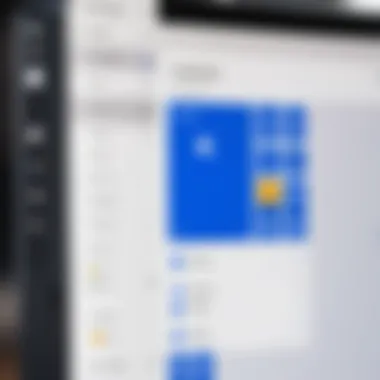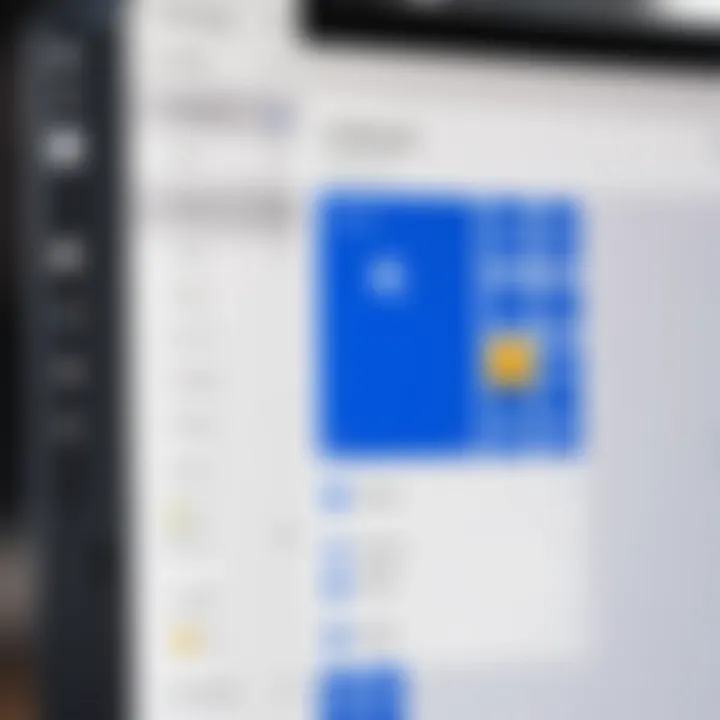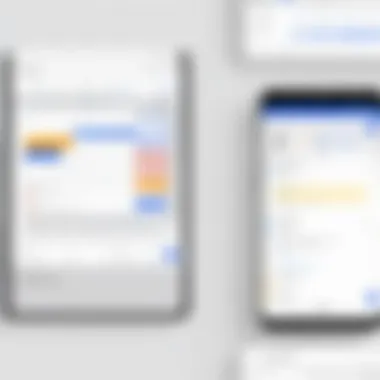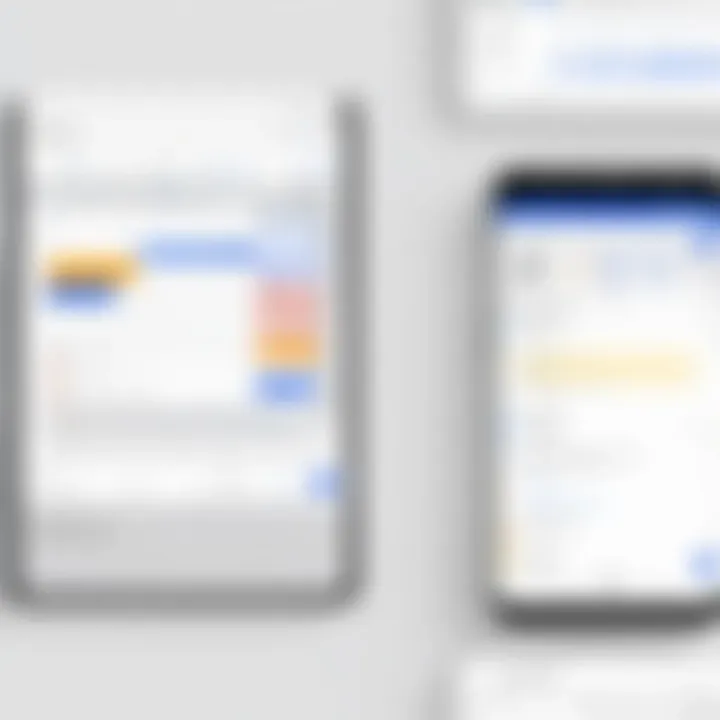Maximize Your Productivity with Google Calendar on Windows 10


Intro
In today’s digitized work and personal environments, managing time effectively has become crucial. The Google Calendar app stands out as a pivotal tool in this landscape, especially for users operating on Windows 10. Its integration into this platform allows individuals to streamline their schedules with ease, promoting productivity and organization. Exploring the various aspects of utilizing this app enhances understanding not only of its features but also of its potential to optimize workflow.
The Google Calendar app offers a myriad of functionalities that cater to both personal and professional demands. From setting reminders for meetings to organizing social events, its versatility makes it an indispensable resource. This guide aims to provide insights into the installation process, key features, synchronization methods, and practical use cases. Additionally, it will address common challenges users may face while highlighting best practices for effective calendar management.
As we progress, we will delve deeper into specific tools within Google Calendar, examining how they can be deployed to facilitate better organization and time management. Readers can expect a comprehensive exploration that equips them with the knowledge necessary to utilize the Google Calendar app effectively within the context of Windows 10.
Intro to Google Calendar
In today’s fast-paced world, effective time management has become a crucial skill. Google Calendar stands out as a powerful tool for organizing schedules, setting reminders, and enhancing productivity. This section focuses on the significance of integrating Google Calendar into daily routines, particularly on Windows 10, an operating system widely adopted by professionals and individuals alike.
Overview of Google Calendar
Google Calendar is a versatile and user-friendly application capable of streamlining event planning and personal schedules. It allows users to create, edit, and share calendars seamlessly. With features such as effortless event creation, notifications, and integration with other Google services, it is an indispensable asset for managing time effectively. The application is accessible across multiple devices, providing flexibility and convenience that users increasingly rely upon.
Additionally, accessing Google Calendar on Windows 10 enhances the experience by allowing users to utilize a larger screen and combining it with other desktop functions. This makes it easier to visualize schedules, drag and drop events, and navigate through upcoming activities without needing to switch devices.
Importance of Calendar Management
Effective calendar management is not merely about keeping track of events; it is about optimizing productivity and time allocation. A well-organized calendar helps users prioritize tasks, meet deadlines, and maintain a work-life balance. By utilizing Google Calendar, individuals can take advantage of several benefits:
- Improved Time Allocation: Users can allocate specific blocks of time for tasks and appointments, minimizing fragmentation.
- Enhanced Accountability: Setting reminders and alerts helps individuals to stay accountable to their schedules.
- Collaboration Opportunities: Google Calendar’s sharing features enable team members to coordinate schedules, fostering better collaboration.
"The ability to structure one's time can lead to significant improvements in both personal and professional outcomes."
Moreover, calendar management encourages users to reflect on their commitments. This reflection process can lead to better decision-making about what to prioritize, ultimately leading to enhanced satisfaction with both work and personal life.
Therefore, understanding the layout and features of Google Calendar is essential for anyone serious about improving their time management strategy. As we proceed into the next sections of this article, we will explore the installation process, key features, and other functionalities that enrich user experience and effectiveness.
Settings Up Google Calendar on Windows
Setting up Google Calendar on Windows 10 is a fundamental step for users who wish to make the most of this powerful scheduling tool. This application is not just about marking dates; it offers improved productivity and organization, making it crucial for both personal and professional spheres. When integrated properly, Google Calendar enhances time management, allowing users to keep track of important appointments and deadlines efficiently. In this section, we will explore how to download the app, go through the installation process, and create a Google account to get started.
Downloading the App from the Microsoft Store
To begin utilizing Google Calendar on Windows 10, the first step is to download the application from the Microsoft Store. The store is carefully curated to ensure that users have access to reliable and secure applications. By choosing Google Calendar from the store, you also ensure that you are downloading the most recent version, which can include updates and security improvements.
- Launch the Microsoft Store on your Windows 10 device.
- Use the search bar to type .
- Click on the Get or Install button to initiate the download.
- Wait for the installation to complete.
This process is simple and user-friendly, making it accessible for all users, regardless of their technical background.
Installation Process
Once you have downloaded the Google Calendar app, the installation process is straightforward. The app is designed with the user experience in mind, ensuring that even those with minimal tech skills can successfully set it up. Follow these steps:
- Locate the App: After the download is finished, locate the Google Calendar app either on your Start menu or directly on the desktop.
- Launch the App: Open the app by double-clicking it. This will lead you to a login screen if you have not logged in yet.
- Follow Prompts: The application will guide you through any necessary prompts to configure settings according to your preference.
After completing these steps, your Google Calendar will be ready to use. You might be required to allow permissions for notifications or calendar access, which can enhance your experience.
Creating a Google Account
Creating a Google account is an essential step if you don’t have one already. The Google Calendar app syncs seamlessly with your Google account, and without it, you cannot access all features of the application. The process is quick and can be completed in a few minutes:
- Open your web browser and go to the Google Account Creation page.
- Fill out the necessary information such as your name, email address, and password.
- Click on the Next button and follow the prompts to complete your sign-up.
Creating a Google account not only gives access to Google Calendar but to other Google applications like Drive, YouTube, and Gmail.


Key Features of Google Calendar on Windows
The Google Calendar app provides various features that significantly enhance the user experience on Windows 10. These features serve not only to simplify scheduling but also to optimize overall productivity. With its user-friendly interface and integration capabilities, the app becomes an essential tool in both personal and professional contexts.
Event Creation and Management
Creating and managing events in Google Calendar is straightforward. Users can easily add new events with specific details such as title, time, and location. The option to include guests and set up video conferencing directly through Google Meet makes managing group events simpler.
Moreover, recurring events functionality allows users to set events that take place regularly. This is particularly beneficial for meetings, appointments, or reminders that have a fixed schedule. Users can choose from multiple recurrence options—daily, weekly, monthly, etc. This saves time and effort in re-entering information for events that happen often.
Reminders and Notifications
Reminders play a critical role in helping users stay organized. Google Calendar allows users to set up various reminders that can alert them via notifications on their devices. Users can choose how far in advance they wish to be reminded, whether it's minutes, hours, or days ahead of time. These reminders ensure that important tasks, meetings, or events do not slip through the cracks.
Notifications also enhance engagement with the upcoming events. Users can receive alerts via email or on their desktop, ensuring they are always aware of what is scheduled. This connectivity is key for busy professionals who rely heavily on time management.
Recurring Events Functionality
The ability to set recurring events is a standout feature in Google Calendar. For example, if a user has weekly team meetings, they can set this event to occur every week on a specific day and time. This function not only streamlines the scheduling process but also significantly reduces the risk of forgetting important commitments. Recurring events can be customized with parameters such as end dates or instances of occurrence, making this feature highly flexible and adaptable.
Sharing and Collaboration Features
Collaboration is increasingly vital in today's working environment, and Google Calendar excels in this area. Users can share their calendars with colleagues or family members, allowing them to see availability in real time. This feature is particularly useful for team projects or family planning.
Once calendars are shared, users can easily create events that include participants, set up reminders, and send invitations. Participants can accept or decline, thus providing clear insight into attendance. This collaborative aspect fosters better communication and reduces scheduling conflicts associated with events that involve multiple people.
"Effective utilization of Google Calendar can transform chaotic schedules into organized plans."
By understanding and utilizing these key features, users can harness the full capabilities of Google Calendar on Windows 10, thereby increasing their productivity and managing time more efficiently.
Synchronizing Google Calendar with Other Applications
Synchronizing Google Calendar with other applications is essential for achieving a seamless workflow. Many users rely on multiple tools for different aspects of their lives, and integration helps streamline processes. By syncing Google Calendar with email clients, task management apps, and platforms like Microsoft Outlook, individuals can enhance productivity, minimize errors, and maintain team alignment.
Linking with Email Clients
Linking Google Calendar to your email client can greatly simplify scheduling and managing events. Most email services, including Gmail, offer built-in synchronization. This integration allows users to view calendar events alongside their emails, creating a unified interface for managing tasks and communications.
For example, receiving an event invitation via email can prompt automatic calendar entry, reducing the chance of missed appointments. Additionally, notifications from calendar events can be directed to the same email client, making it easier to stay on top of your schedule.
Integrating Task Management Apps
Integrating Google Calendar with task management applications is beneficial for anyone looking to organize their projects effectively. Many task apps, like Trello or Asana, offer options to sync with Google Calendar, allowing users to see deadlines and commitments all in one place.
This consolidation fosters a better understanding of timelines. Users can visualize how their tasks fit within their schedule, making adjustments easier when necessary. Furthermore, real-time updates ensure that changes made in either platform are reflected in the other, thus maintaining consistency.
Using Google Calendar with Microsoft Outlook
The integration between Google Calendar and Microsoft Outlook is particularly valuable for professionals who often navigate between these two platforms. By setting up the Google Calendar in Outlook, users can manage appointments and tasks from a single interface.
This setup allows for viewing all events from both calendars without switching applications. To enable this functionality, one can add the Google Calendar to Outlook by entering the calendar's URL or using the Outlook add-in for Google Calendar.
It is worth noting that Microsoft provides detailed instructions for setting up this integration, which can be found on their support page. The end result is a more organized workflow that minimizes the need for duplication of entries and potential conflicts.
"Using multiple applications effectively is crucial for modern productivity; synchronization is key to achieving that goal."
In summary, synchronizing Google Calendar with other applications significantly enhances users' productivity. The convenience of linking with email clients, integrating task management apps, and collaborating with Microsoft Outlook creates a more coherent and efficient workflow. This integration is not just a time-saver; it also allows for better organization and prioritization of tasks throughout the day.
Best Practices for Utilizing Google Calendar
Utilizing Google Calendar effectively is crucial for optimal time management and organization. In this section, we will discuss best practices that can enhance productivity and simplify event management. By following these practices, users can not only keep track of their commitments but also avoid overwhelm. Those who integrate Google Calendar into daily lives will find it easier to remain organized and efficient.
Organizing Events Effectively
Organizing events in Google Calendar requires a thoughtful approach. Set clear titles for each event that accurately reflect its purpose. This will make it easier to skim through the calendar later. Take advantage of the description field. Adding meeting agendas or important notes ensures that all relevant details are one click away.
Another effective method is to set specific time slots for tasks. This technique enhances focus by carving out dedicated periods for individual activities. Rather than lumping together various commitments, create distinct entries for each task. This approach prevents confusion and helps maintain a structured schedule.


Tip: Regularly review your calendar at the start and end of each week. This practice allows you to adjust any tasks or events that no longer apply, keeping your schedule fluid and relevant.
Utilizing Color-Coding for Tasks
Color-coding events is a simple yet powerful tool to distinguish between various types of tasks or commitments. For instance, use one color for professional obligations and another for personal events. This visual distinction aids in quickly assessing the day's or week's responsibilities without much effort.
Implement a color scheme that resonates well with your work style. Perhaps green for meetings and red for deadlines. This system plays a role in prioritizing tasks as well. Vivid colors for urgent matters can act as a reminder to address them promptly. Also, once color-coding is established, you can create a key. A key serves as a handy reference that keeps your coding consistent.
Leveraging Mobile Access
Google Calendar offers mobile access through its app, allowing you to manage your events on the go. This feature is especially beneficial for professionals who frequently travel or have varying schedules. With the app, you can quickly check, add, or modify events right from your smartphone.
Moreover, enable notifications for upcoming events. These timely alerts can help avoid missed appointments or tasks. Integration with your device's calendar is also advantageous. This ensures all personal and professional commitments are consolidated in one view.
Finally, don’t forget the offline mode. When internet access is limited, the mobile app allows viewing and editing of calendar entries. Edits will synchronize automatically once a connection is established again.
By employing these best practices, users can maximize the benefits of Google Calendar. Effective organization, strategic color coding, and mobile access enhance overall productivity and time management. This approach ensures calendar management is not just about recording events but truly optimizing workflows.
Addressing Potential Issues
Addressing potential issues with the Google Calendar app on Windows 10 is crucial for maintaining a seamless user experience. Users may encounter various challenges that can hinder productivity and disrupt the effectiveness of calendar management. By understanding these issues and learning how to troubleshoot them, users can minimize frustration and optimize their use of the app. This section covers common sync problems, troubleshooting strategies, and dealing with notification glitches that users might face.
Common Sync Problems
Users often report sync issues with Google Calendar on Windows 10. These problems can manifest in several ways, such as events not appearing or being updated across devices. Common causes for these sync issues include:
- Internet connectivity: A stable internet connection is essential for proper syncing.
- Account settings: Incorrect account configurations can prevent proper data exchange.
- App permissions: In some cases, insufficient permissions can block the app from accessing necessary data.
Resolving these sync problems may involve checking the network connection, ensuring that the Google account is logged in correctly, or reauthorizing the app’s permissions.
Troubleshooting the App
When issues arise with the Google Calendar app, troubleshooting is essential to find a solution. Here are some effective strategies:
- Restart the app: Sometimes, simply closing and reopening the app can resolve temporary glitches.
- Clear app cache: Cached data can interfere with the app’s performance. Clearing it from the app’s settings can help improve functionality.
- Reinstall the application: If problems persist, uninstalling and reinstalling the Google Calendar app may restore its performance.
This structured approach for troubleshooting can be systematic. When one solution fails, proceed to the next until the issues are resolved.
Dealing with Notification Glitches
Notification glitches are another common issue users may encounter. These can include missed alerts, delayed notifications, or no notifications at all. To address these problems, consider the following actions:
- Check notification settings: Ensure that notifications are enabled both in the app and within Windows 10 settings.
- Update the app: Outdated versions may contain bugs. Keeping Google Calendar updated can prevent such glitches.
- Examine focus assist settings: Sometimes, focus assist features can unintentionally silence app notifications.
By regularly checking settings and adjustments, users can help ensure they do not miss important reminders and events.
Exploring Advanced Features
Understanding the advanced features of the Google Calendar app on Windows 10 is essential for optimizing user productivity. These features not only enhance the basic functionalities of the calendar but also integrate seamlessly with various tools and platforms. By exploring these advanced capabilities, users can tailor their experience to better suit their personal or professional needs. Let's delve into three significant aspects: Google Calendar Labs, third-party extensions, and customizing calendar views.
Using Google Calendar Labs
Google Calendar Labs offers users experimental features that can enhance their calendar experience. These features are meant to provide additional functionalities that are not yet fully integrated into the core app. Accessing Google Calendar Labs allows users to test out various tools that might suit their workflow better.
To utilize this feature, you need to visit the settings in Google Calendar. In the settings menu, there usually is a 'Labs' section, where you can enable or disable different experimental features. For instance, options like custom event colors or enhanced sharing settings can really make a difference in organizing events efficiently.
Some key benefits of using Labs include:


- Customization: Experimenting with different features helps personalize your calendar experience.
- Productivity Tools: Some tools can automate certain tasks, saving time.
- Early Access: Gain insights into upcoming features and feedback options.
Incorporating Third-party Extensions
Another crucial area is the incorporation of third-party extensions. These extensions can significantly enhance Google Calendar's functionality beyond its predefined capabilities. Various tools, like Zapier or Todoist, can be integrated to streamline workflows. For professionals who juggle multiple tasks, these integrations can connect calendars with task management systems and email clients, providing a cohesive workspace.
To add third-party extensions, navigate to the settings again and look for an option that allows integration. The extensions usually have guided processes for setup, which ensures that users experience minimal interruptions during integration.
Benefits of these extensions include:
- Increased Efficiency: Tools designed for specific tasks can simplify processes.
- Time Management: Automating event creation and reminders can optimize time management.
- Enhanced Collaboration: Working with team members in real time helps improve communication.
Customizing Calendar Views
Customization of calendar views is essential for effective monitoring of tasks and events. Google Calendar allows several customization options, like switching to a week, month, or agenda view. Adjusting the calendar display settings according to your work style is highly advantageous.
Users can select color schemes, change the start day of the week, or set preferences for what information is displayed on the main calendar. These small adjustments can significantly improve visual clarity and help users better prioritize their schedules.
Key considerations for customizing views include:
- Visibility of Events: Ensure critical events are visually prominent.
- User Preferences: Adapt the calendar according to personal comfort for ease of use.
- Maintain Focus: Limit distractions by choosing focused views based on daily tasks.
In summary, exploring advanced features within the Google Calendar app enhances user experience and bolsters productivity. By utilizing Google Calendar Labs, incorporating third-party extensions, and customizing views, professionals can align the app more closely with their workflows, thereby managing time and tasks more effectively.
The Future of Google Calendar on Windows
The evolution of digital tools continues to shape how we organize our lives. As a significant player in the productivity arena, Google Calendar is consistently adapting to meet user needs. The future of Google Calendar on Windows is not just about feature updates. It encompasses how these changes impact usability, efficiency, and overall productivity.
Staying ahead means understanding the upcoming enhancements that Google plans to integrate into the platform. These enhancements aim to streamline user experiences and minimize disruptions. Furthermore, integrating advanced technologies, like AI and machine learning, can offer users smarter scheduling solutions and better resource management. This adaptive nature is crucial for business professionals and tech-savvy individuals needing efficient time management solutions.
Upcoming Features and Updates
Google is continuously looking to refine Google Calendar. Some upcoming features are set to enhance its functionality on Windows 10. These updates include:
- Improved User Interface: A redesigned interface is on the roadmap. This will include better accessibility and intuitive navigation, making it easier to access events and settings.
- Smart Suggestions: Utilizing AI, Google Calendar will provide more contextual suggestions. These can include optimal meeting times based on availability and calendar history.
- Enhanced Integration with Google Workspace: Users can expect more seamless connections with tools like Google Meet and Chat to facilitate better communication and collaboration.
- Advanced Privacy Features: Upgraded privacy settings will give users more control over who can see events or access calendars, vital for preserving confidentiality in professional settings.
Each of these features shows how Google Calendar is evolving to meet the demands of users who require more than just basic functionalities. As these updates roll out, they will enhance the integration of the app within the existing Windows ecosystem.
Trends in Calendar Technology
The field of calendar technology is witnessing significant trends that influence tools like Google Calendar. Recognizing these trends is vital for users who want to leverage technology for optimizing their schedules.
- AI-Driven Features: Artificial intelligence is becoming a cornerstone in calendar applications. Predictive analytics will allow Google Calendar to anticipate scheduling conflicts and suggest resolutions.
- Cross-Platform Functionality: The push for integration across various platforms will continue to grow. Users expect their calendar to sync seamlessly with other applications, such as task managers and email services.
- Focus on Collaboration: As remote work gains prevalence, tools that promote collaboration will be prioritized. Google Calendar's ability to create shared calendars and event invites aligns well with this trend.
- Personalization Options: Users increasingly seek customizable tools. Options to personalize notifications, themes, and views will become more prominent.
Understanding these trends can provide insight into how Google Calendar will align itself with user needs. Embracing these changes is crucial in an ever-changing technological landscape.
End
The conclusion of this article serves to encapsulate the key discussions around utilizing the Google Calendar app on Windows 10. In a world where effective time management is essential for both personal and professional success, Google Calendar offers a structured solution. This section highlights specific elements that enhance one's organizational capabilities while considering the various benefits and considerations that come with its implementation.
Summary of Key Takeaways
To summarize, Google Calendar provides remarkable features designed to improve productivity. These include:
- Event Creation and Management: Easy scheduling leads to better time allocation.
- Reminders and Notifications: Staying informed ensures that tasks and appointments are not forgotten.
- Synchronization with Other Applications: This allows for seamless integration into existing workflows.
- Sharing Features: Collaborating with others becomes straightforward.
These aspects collectively re-emphasize the efficiency and utility of Google Calendar. Adopting this tool can transform how one approaches organization. The communication of tasks and events improves collaboration, thus fostering teamwork and enhancing individual productivity.
Final Thoughts on Implementation
Implementing Google Calendar on Windows 10 merits careful consideration. While the app offers significant advantages, users must also adapt their habits to maximize its benefits.
- Users are encouraged to regularly review their calendar configurations.
- Engaging with the mobile access feature can ensure that updates and reminders remain consistent, no matter where one is.
- In addition, utilizing color-coding for various tasks can create a visual structure that simplifies workflow.
In summary, the integration of Google Calendar into your daily routine presents an opportunity for improved management of tasks and time. While challenges may arise, addressing these through troubleshooting and adjustments will lead to a more productive experience. As competition in the professional world escalates, mastering tools like Google Calendar becomes not just beneficial, but essential.







